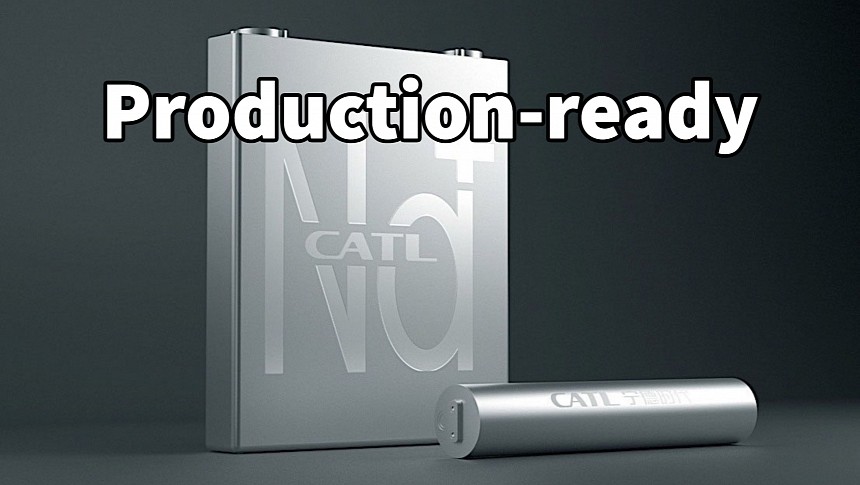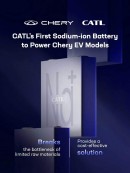China is preparing mass production of sodium-ion batteries, as CATL and BYD announced plans to install the novel cells into production vehicles. Despite their relatively low energy density, sodium-ion batteries promise significant advantages over their Li-Ion counterparts.
The world faces another industrial revolution as electric vehicles take the market by storm. As lithium becomes more expensive, companies and scientists all over the world are trying to find better alternatives to Li-ion batteries. China is at the forefront of these efforts, as the West remains blinded by the ternary cells it's been using for decades. The US, European, and Korean companies have made the same mistake in the past as China adopted the LFP (Lithium-Iron-Phosphate) cells.
Back then, the LFP cells were considered unfit for automotive because of their low energy density. The chemistry proved successful in China, thanks to its cheap production costs. The biggest battery producer in the world, CATL, is also the leader in LFP batteries, which are now used extensively in all domains. After Tesla introduced them to Westerners, LFP cells entered the mainstream. All major car companies are planning EV models powered by affordable LFP cells.
The story is poised to repeat with sodium-ion (Na-ion) cells. These, too, have a lower energy density, sometimes even lower than LFP cells. That made most in the US and Europe dismiss them as fit for energy storage only. Nevertheless, CATL and BYD announced the first sodium-Ion batteries installed in mass-produced cars, proving they are suitable for electric vehicles. Before we know it, sodium-ion will become as widespread as LFP cells, with Chinese companies as their sole suppliers.
Unlike lithium, sodium is cheap and abundant, which makes Na-ion batteries much more affordable. They also have advantages such as better low-temperature performance and faster charging speeds compared to Li-ion cells. Regarding safety and durability, they are on par with the LFP cells, with the only disadvantage of lower energy density. Still, CATL has developed Na-ion cells with an energy density of 160 Wh/kg, slightly lower than LFP cells. The next generation of Na-ion cells already promises improved performance, surpassing 200 Wh/kg.
In terms of pricing, CATL's first-generation sodium-ion cells cost about $77 per kWh. For years, experts believed that a battery price under $100/kWh allows EVs to achieve price parity with combustion vehicles. The second generation has the potential to drop the price to $40 per kWh, making electric cars a no-brainer. To increase the battery pack performance, CATL intends to combine Na-ion and Li-Ion cells, thus extending the EV range.
The first car models using Na-ion batteries are from Chery's brand iCAR, expected to launch in the fourth quarter of 2023. Chery will also use CATL's Na-ion cells in its smaller EVs, such as the QQ Ice Cream and the Little Ant, according to CnEVPost. BYD will also have a version of the BYD Seagull powered by Na-ion batteries by year's end. However, the company dismissed previous rumors as being "fake news."
Back then, the LFP cells were considered unfit for automotive because of their low energy density. The chemistry proved successful in China, thanks to its cheap production costs. The biggest battery producer in the world, CATL, is also the leader in LFP batteries, which are now used extensively in all domains. After Tesla introduced them to Westerners, LFP cells entered the mainstream. All major car companies are planning EV models powered by affordable LFP cells.
The story is poised to repeat with sodium-ion (Na-ion) cells. These, too, have a lower energy density, sometimes even lower than LFP cells. That made most in the US and Europe dismiss them as fit for energy storage only. Nevertheless, CATL and BYD announced the first sodium-Ion batteries installed in mass-produced cars, proving they are suitable for electric vehicles. Before we know it, sodium-ion will become as widespread as LFP cells, with Chinese companies as their sole suppliers.
Unlike lithium, sodium is cheap and abundant, which makes Na-ion batteries much more affordable. They also have advantages such as better low-temperature performance and faster charging speeds compared to Li-ion cells. Regarding safety and durability, they are on par with the LFP cells, with the only disadvantage of lower energy density. Still, CATL has developed Na-ion cells with an energy density of 160 Wh/kg, slightly lower than LFP cells. The next generation of Na-ion cells already promises improved performance, surpassing 200 Wh/kg.
In terms of pricing, CATL's first-generation sodium-ion cells cost about $77 per kWh. For years, experts believed that a battery price under $100/kWh allows EVs to achieve price parity with combustion vehicles. The second generation has the potential to drop the price to $40 per kWh, making electric cars a no-brainer. To increase the battery pack performance, CATL intends to combine Na-ion and Li-Ion cells, thus extending the EV range.
The first car models using Na-ion batteries are from Chery's brand iCAR, expected to launch in the fourth quarter of 2023. Chery will also use CATL's Na-ion cells in its smaller EVs, such as the QQ Ice Cream and the Little Ant, according to CnEVPost. BYD will also have a version of the BYD Seagull powered by Na-ion batteries by year's end. However, the company dismissed previous rumors as being "fake news."






